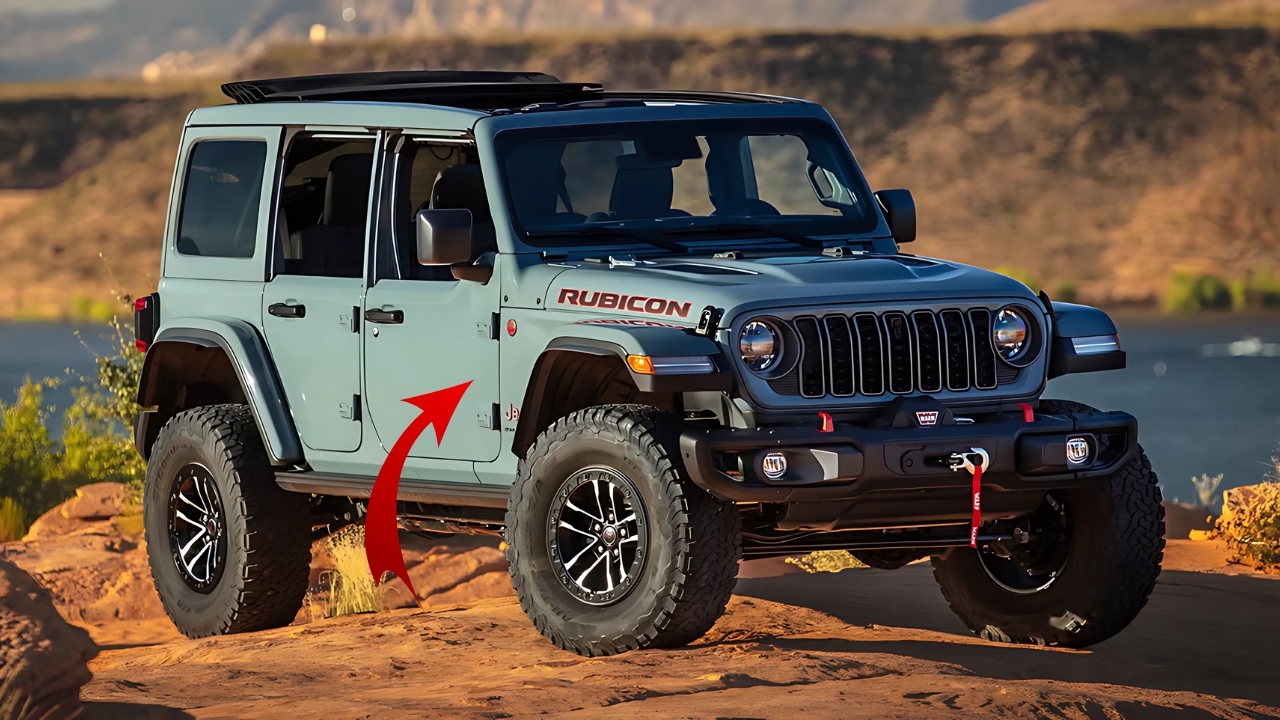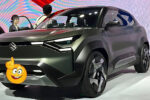Jeep Wrangler: The Wrangler’s story begins not with itself but with its predecessor, the Willys MB—the original “jeep” that helped win World War II.
Developed in response to the U.S. Army’s need for a light reconnaissance vehicle, the MB’s simple, rugged design proved transformative on battlefields across Europe and the Pacific.
Its go-anywhere capability, mechanical simplicity, and sheer versatility made it one of the most important vehicles of the conflict.
After the war, Willys recognized civilian potential in their military workhorse and introduced the CJ (Civilian Jeep) series.
These early models maintained nearly identical design and engineering to their military counterparts, with only minimal concessions to civilian comfort.
The CJ established the template that all future Wranglers would follow: body-on-frame construction, solid axles front and rear, removable doors and top, folding windshield, and round headlights flanking a simple slotted grille.
Through successive iterations from CJ-2A through CJ-7, these vehicles carved out a unique position in the automotive landscape—not quite trucks, not quite cars, and certainly not comparable to conventional SUVs that would later flood the market.
They represented something different: purpose-built tools for outdoor adventure that sacrificed on-road refinement for off-road capability without apology.
The Wrangler name itself didn’t appear until 1986, when the YJ generation replaced the long-running CJ series. Despite the name change, the vehicle maintained its core identity while introducing wider tracks, slightly more comfortable interiors, and improved safety features.
The controversial square headlights of the YJ gave way to the return of round lights with the TJ generation in 1997, which also introduced coil spring suspension in place of leaf springs—perhaps the most significant chassis evolution in the vehicle’s history up to that point.
Jeep Wrangler: The Modern Era- Refining Without Compromising
The current Wrangler has evolved through the JK generation (2007-2018) and into the present JL model introduced for 2018.
These modern interpretations have managed something that seemed almost impossible: maintaining the vehicle’s core capability and character while dramatically improving refinement, technology, and efficiency.
The JL generation in particular represents the most advanced Wrangler ever produced, offering amenities that would have seemed fantastically out of place on earlier models: LED lighting, touchscreen infotainment with smartphone integration, advanced safety systems, and even mild hybrid powertrains.
Yet despite these modernizations, the vehicle remains instantly recognizable and mechanically faithful to its forebears.
Most critically, Jeep engineers have steadfastly refused to abandon the fundamental mechanical elements that define a proper Wrangler: solid axles, a separate body and frame, a transfer case with proper low range, and abundant ground clearance.
These features represent significant compromises in on-road comfort, fuel economy, and interior space compared to car-based crossovers, yet they remain non-negotiable aspects of the Wrangler’s identity.
This unwavering commitment to off-road capability has paid dividends in maintaining the model’s authenticity even as annual sales have grown dramatically.
What was once a niche vehicle with modest production numbers has become a cornerstone of Jeep’s global business, selling hundreds of thousands of units annually across international markets.
Engineering for Extremes: Why Wranglers Work Off-Road
To understand the Wrangler’s enduring appeal among serious off-road enthusiasts requires appreciating the engineering decisions that prioritize capability over comfort.
Unlike most modern vehicles designed primarily for paved roads with occasional light-duty trail use, the Wrangler is engineered from the ground up to excel in extreme terrain.
The solid front and rear axles represent perhaps the most significant technical differentiator between the Wrangler and conventional SUVs.
While independent suspension systems provide superior on-road handling and ride quality, solid axles offer several critical advantages in challenging off-road situations: greater articulation (keeping wheels in contact with uneven surfaces), superior durability against impacts, simpler protection of vulnerable components, and easier modification for increased capability.
The two-speed transfer case provides a proper low-range gear reduction, typically around 4:1, that effectively multiplies engine torque for crawling over obstacles or navigating steep inclines.
This feature, absent on most crossovers and increasingly rare even on truck-based SUVs, transforms how the vehicle behaves in technical terrain.
Ground clearance—the distance between the lowest point of the vehicle and the ground—remains exceptional across all Wrangler variants, with specialized models like the Rubicon offering over 10 inches of running clearance.
Equally important are the approach, breakover, and departure angles that determine how steep an obstacle the vehicle can negotiate without making contact with the bumpers or undercarriage.
The Rubicon models, named after the legendary trail in California’s Sierra Nevada mountains, add further specialized equipment: electronic locking differentials front and rear, an electronic disconnecting front sway bar for increased articulation, lower crawl ratios, and more aggressive off-road tires straight from the factory.
These features make the Rubicon capable of navigating terrain that would stop most other production vehicles, regardless of price.
The Ownership Experience: Community and Customization
Owning a Wrangler extends beyond the typical vehicle purchase into entry into a distinct cultural community.
The famous “Jeep wave” exchanged between passing Wrangler drivers symbolizes this shared identity—an acknowledgment of common values and experiences that transcends demographics and geography.
This community manifests most visibly in the proliferation of Jeep-specific events, from local club runs to massive gatherings like the Easter Jeep Safari in Moab, Utah, which draws thousands of enthusiasts annually for a week of challenging trail riding and social connection.
These events reinforce the vehicle’s role not merely as transportation but as the enabler of a particular lifestyle and set of experiences.
Central to Wrangler culture is the almost limitless potential for customization. With the possible exception of Harley-Davidson motorcycles, few vehicles support such an extensive aftermarket.
From simple aesthetic modifications to comprehensive reengineering for extreme terrain, the Wrangler serves as a platform for personal expression and capability enhancement.
This customization extends to the factory-stock experience through the vehicle’s transformable nature. Doors remove with simple tools, various top configurations (hard, soft, no top at all) change the driving experience dramatically, and even the windshield folds down for maximum connection with the surroundings.
This adaptability allows one vehicle to serve multiple purposes—enclosed transportation during inclement weather, open-air freedom in favorable conditions, and optimized configurations for different types of off-road challenges.
The Compromises: Living With a Purpose-Built Machine
Wrangler ownership demands acceptance of compromises that would be unacceptable in most modern vehicles.
Wind noise remains considerable even in the latest generation, fuel economy lags behind similarly sized crossovers, on-road handling prioritizes durability over precision, and interior space efficiency suffers from the constraints of the traditional shape and mechanical layout.
Yet these compromises represent not deficiencies but conscious design decisions that preserve the vehicle’s core identity and capability.
Jeep engineers have progressively mitigated these characteristics—the current JL generation rides, handles, and isolates noise dramatically better than its predecessors—but have refused to eliminate them entirely when doing so would undermine the Wrangler’s fundamental character.
This philosophy manifests clearly in the current powertrain lineup, which spans from the traditional (a 3.6-liter naturally aspirated V6) to the thoroughly modern (a 2.0-liter turbocharged four-cylinder with mild hybrid assistance and even a 4xe plug-in hybrid variant).
These newer options improve efficiency without sacrificing the torque delivery and reliability essential for off-road use. Even the V6 diesel option, available in some markets, emphasizes low-end torque and range between refueling rather than outright speed.
Cultural Impact: Beyond Transportation
The Wrangler’s influence extends far beyond its sales numbers or technical specifications. It has achieved that rarest of automotive distinctions—immediate recognition even among those with no interest in cars or trucks.
Like the Porsche 911, Volkswagen Beetle, or Ford Mustang, the Wrangler’s silhouette has become a cultural shorthand that communicates specific values and associations.
In marketing and popular media, the Wrangler frequently symbolizes adventure, freedom, and authentic outdoor experiences.
It appears in contexts ranging from beach lifestyle imagery to rugged backcountry exploration, adapting to diverse narratives while consistently representing escape from everyday constraints.
This versatility in cultural applications parallels the vehicle’s physical versatility in navigating diverse terrains.
Perhaps most tellingly, the Wrangler has largely avoided the fate of other off-road icons like the Land Rover Defender or Mercedes G-Class, which have evolved toward luxury positioning and corresponding price points that distance them from their utilitarian origins.
While Jeep offers increasingly premium Wrangler variants with sophisticated features and materials, the model range still includes relatively affordable entry points that maintain accessibility to a broad audience.
The Future: Tradition Meets Technology
As automotive markets rapidly transition toward electrification and increased automation, the Wrangler faces perhaps its most significant evolutionary challenge.
The emerging 4xe plug-in hybrid variant represents Jeep’s first attempt to reconcile the model’s traditional character with modern efficiency demands, offering limited electric-only range while maintaining all the expected off-road capability.
This approach—using new technology to enhance rather than replace the core experience—will likely guide the Wrangler’s future development. Electrification offers intriguing possibilities for off-road vehicles, with electric motors’ instant torque delivery and precise control potentially enhancing capability in technical terrain.
However, range anxiety takes on additional dimensions when operating far from charging infrastructure, suggesting that hybrid systems may represent the optimal balance for the foreseeable future.
Likewise, while driver assistance features will undoubtedly increase in sophistication, the Wrangler seems likely to maintain a higher degree of direct driver involvement than mainstream vehicles.
The intense connection between driver, vehicle, and environment remains fundamental to the Wrangler experience, particularly in challenging off-road situations where human judgment and feedback often outperform automated systems.
Jeep Wrangler: Authentic in an Age of Compromise
In an automotive landscape increasingly dominated by vehicles designed to be everything to everyone, the Jeep Wrangler stands apart through its unwavering commitment to a singular purpose.
While it has expanded its capabilities to accommodate everyday use better than any previous generation, it refuses to compromise the core attributes that define its identity.
This authenticity explains why the Wrangler inspires devotion rather than merely satisfaction among its owners.
It represents a conscious choice to prioritize character and capability over convenience and comfort—a proposition increasingly rare in an era of homogenized transportation appliances. For those who value these distinctions, no substitute exists or seems likely to emerge.
The Wrangler’s remarkable balancing act—honoring tradition while embracing appropriate innovation—ensures its continued relevance despite changing market trends.
As long as wilderness exists to be explored and drivers seek vehicles with distinctive character, the Wrangler will likely maintain its position as the definitive accessible off-road vehicle and one of the few remaining automotive icons with legitimate claim to authentic heritage.



